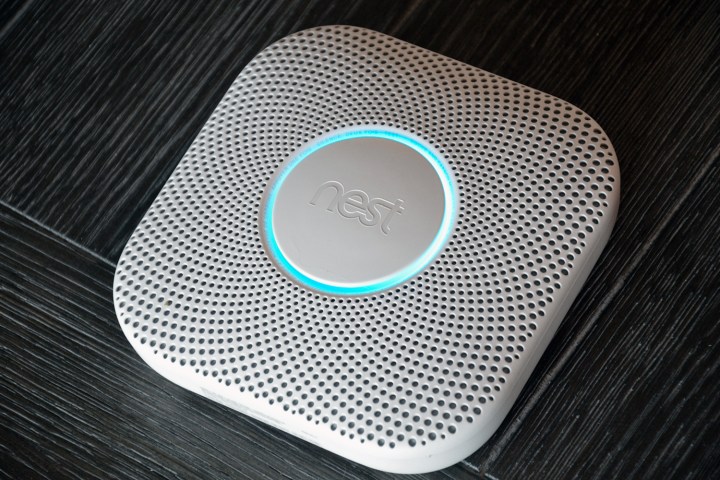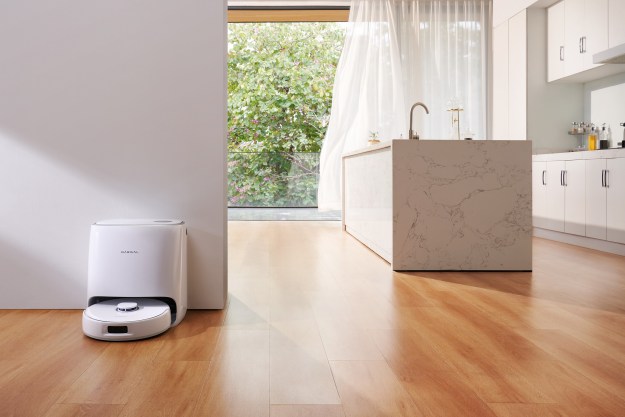
For the fifth installment in our Digital Trends Smart Apartment series, we’re exploring smart smoke alarms. Many smart-home products fall into the security or convenience camps, and smart smoke and carbon monoxide detectors fit in both. They’re meant to keep you safe in the same way traditional alarms are, but with a bit of added functionality.
With a dumb smoke alarm (probably the one you own), you will never know if it goes off when you’re not home, and the only time it notifies you is when your battery is low via annoying chirps.
Any smart smoke detector you buy should still work like a standard alarm, even if it’s knocked offline. Also, if your smoke detectors are hardwired, your landlord may not appreciate you installing new ones, so keep that in mind.
You could install a smart battery instead
If you’re looking for a simple, relatively inexpensive upgrade, there’s the Roost Smart Battery. For $35, you can replace the 9-volt battery in your ordinary smoke alarm with a Wi-Fi-enabled battery that will send you notifications when it’s low on juice, if there’s a false alarm, or if there’s an actual fire. It connects to your Wi-Fi and is app controlled, so you can silence alarms from your phone instead of having to get on a ladder to press the device’s button. Keep in mind that this will only work if your current detector works with a 9-volt battery.

(A side note: In April, I got a notification that my Roost battery was running low — several months after I’d received it, as opposed to the five years it’s supposed to last. The reason I knew wasn’t chirping, but because I got an email from customer support, offering to send a new one free of charge. It seems other people had the same problem, but that is one advantage of having a connected device: The company can keep an eye on its products. That may or not may creep you out, though.)
Roost also makes a four-in-one smoke, fire, carbon monoxide, and natural gas detector. The detector itself isn’t smart; it just relies on a Roost battery for its connectivity. If you’re looking for a fully new detector with natural gas-detecting abilities, it is cheaper than some of the competition, but it also requires hardwiring. That means you might want to call an electrician to install it. If you own a separate natural gas and CO detector, it would be less expensive but you lose the smarts.
Why I bought a Nest Protect smart smoke alarm
When I moved in, my place had a single, battery-operated smoke alarm in the hallway, next to the bedroom. If something ignited in the kitchen, the smoke would have to waft all the way through the dining area to the living room to reach it. I decided to add a second smart alarm.
Luckily, Nest makes its Protect smoke alarm in a battery version, in addition to the hardwired option. It lacks the natural gas detection of the Roost, but calling an electrician and wiring a couple of alarms isn’t in the cards.
I’m wary of entrusting something as important as a smoke alarm to a smart device.
Since it’s Nest, the Protect looks different from conventional smoke alarms. It’s squarish, with rounded corners. It doesn’t even take a 9-volt battery; instead, it takes six AAs. Nest says its device is more than just a pretty design. It uses both photoelectric and ionization sensors to detect both smoldering and full-on burning fires. You want both so you’re covered no matter what kind of fire you have on your hands. Also, the Protect has a humidity sensor, so it shouldn’t sound just because you take a steamy shower.
Setup took 20 minutes, but that’s only because I wasn’t quick enough the first time around; I was supposed to hit the button for English, but I missed the window and the Nest started speaking in Spanish. I restored factory settings; otherwise, it would have taken half the time to set up. (You can change the language your device speaks in the app, but it warned that it could take “less than a day” to make the switch.)
The ring on the Protect glows several different colors. While it’s off most of the time, it turns yellow as a warning if it detects low amounts of CO or smoke or if the sensors are malfunctioning or it’s time to change the batteries; red means there are high levels of smoke or CO; green means everything’s back to normal; and blue is for setup and pairing. You have the option of making turning the ring into a “pathlight” that glows soft white at night. During the yellow light warning phase, a calm voice tells you smoke is detected, so you have a bit of time to silence it before it begins blaring, provided you just burnt your toast and aren’t in a fire.
I connected Nest Protect to my smart lights
The Protect, being part of Google, is a little more integrated. It works with both IFTTT and Yonomi, a similar app for creating events triggered by other events. For both Roost and the Protect, I can set up an IFTTT to have my Philips Hue lights blink or turn red. The options in Yonomi are a little more customizable; I can have them cycle through colors or choose the amount of times I want them to blink. Lifx bulbs are very customizable through IFTTT, so I have those bulbs blinking a random color at 100 percent brightness 100 times when the smoke or CO alarm goes off.
Roost doesn’t work with my Wink Hub 2, but Nest Protect does. Unfortunately, it doesn’t offer greater — or even as much — functionality as connecting to Yonomi does. It seems like blinking lights are the way to go when it comes to a visual cue that the alarm is going off. If you are a heavy sleeper or have hearing loss, there should be a way to help rouse you. And if it’s the middle of the day, my lights just turning red probably won’t draw my attention the way flashing red bulbs would.
Nest products work with Alexa and Google Home, but that doesn’t seem to be much help when it comes to the Protect — probably because, for safety reasons, the company doesn’t want you silencing its alarm with a voice command.
It’s hard to trust a smart alarm
I have to admit, I’m a little wary of entrusting something as important as a smoke alarm to a smart device. Nest has had its share of problems with the Protect, and a bug with the thermostat in January 2016 left many with cold homes. I fully unplugged my router and sprayed artificial smoke on the Protect, and it still came to life to issue a warning. Thus far, my Protect hasn’t freaked out, but I am keeping the old, non-connected one on standby, just in case.
Editors' Recommendations
- Nest makes two-factor authentication mandatory for its smart home devices
- Google goes all-in on Nest with a total rebrand of its smart home devices






